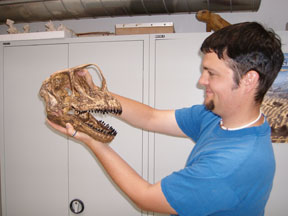|
News Notes
Paleontology
Dwarfing Earth’s largest dinosaur
 When
compared to their counterparts today, animals and plants in the late Jurassic
period, about 161 million to 145 million years ago, appear super-sized.
Newly discovered dinosaur fossils show, however, that the largest animal
to ever walk on Earth also came in a dwarfed version.
When
compared to their counterparts today, animals and plants in the late Jurassic
period, about 161 million to 145 million years ago, appear super-sized.
Newly discovered dinosaur fossils show, however, that the largest animal
to ever walk on Earth also came in a dwarfed version.
Nils Knötschke of the Münchehagen Dinosaur Park in Germany shows off a reconstruction of the newly discovered dinosaur species’ dwarf-sized skull. Europasaurus holgeri’s skull is more blunt-shaped than Brachiosaurus’ skull, but it retains a bulge on top. Photograph is courtesy of Münchehagen Dinosaur Park.
Europasaurus holgeri, as scientists call the newly discovered dinosaur species, belongs to the group of four-legged, plant-eating sauropods, which are known for their colossal sizes and sweepingly long necks and tails. Included in that group is the well-known Brachiosaurus, one of the largest dinosaurs, measuring up to 25 meters (82 feet) long. At only one-quarter of that size, however, Europasaurus is helping paleontologists figure out how and why certain species reached certain sizes.
Martin Sander, a paleontologist at the University of Bonn in Germany, and colleagues unearthed fossils of 11 individual sauropods buried in northern Germany. The sauropods were land dwellers, yet the new fossils were found in a massive bed surrounded by sea creatures. That location indicates that the dinosaurs lived somewhere other than where they died, most likely on a group of nearby islands, says Octávio Mateus, a paleontologist at New University of Lisbon in Portugal who worked on the study.
To find out if the small dinosaurs were youths or dwarfs, the team used a method that is similar to counting rings of a tree to analyze bone from six near-complete skeletons. As the team reported in the June 8 Nature, the largest skeleton (6.2 meters long from head to tail) was indeed fully grown, and Sander estimates it was about eight or nine years old.
The study represents the first time the relatively new bone-analysis method has confirmed a case of “island dwarfism” in dinosaurs. “These are the sauropods that didn’t get the memo that told them that sauropods were supposed to be giants,” says Thomas Holtz, a vertebrate paleontologist at the University of Maryland in College Park.
In addition to Europasaurus’ small stature and shortened neck and tail, its blunt skull also sets it apart from its more-specialized Brachiosaurus relatives, Mateus says. Some features, however, are similar: For example, in the 1993 movie Jurassic Park, “Brachiosaurus is the dinosaur that sneezes on the kids and the snot comes out of this enlarged nasal bulge on the top of the head,” Holtz says. “Europasaurus has this bulge as well.”
The team suggests that Europasaurus’ small size likely evolved as a result of island dwarfism — a phenomenon dictating that smaller animals preferentially survive among a group competing for limited resources in an island environment. “We see this sort of pattern in plenty of other animals in Earth’s history,” Holtz says, noting the dwarf woolly mammoth fossils found off the California coast on Catalina Island.
However, Jeff Wilson, a paleontologist at the University of Michigan in Ann Arbor who specializes in sauropods, thinks that there could be other explanations for Europasaurus’ small size. “Maybe being small or staying small allows them to compete against juveniles for other resources,” he says. “The door left open is how that miniaturization happened.”
Kathryn Hansen

 Subscribe
Subscribe

